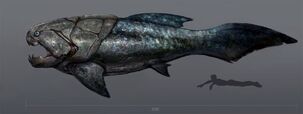
Eridanos IV is an Imperial world of pleasant climate, home to many resorts and personal estates of prominent Sidhae, yet few are brave enough to swim in it's warm oceans. Panzersharks are the reason why.
Overview[]
Overall, Eridanos IV is very much like Earth 400 million years ago during the Devonian. There is little native land flora or fauna to speak of, most of it being introduced Terran lifeforms. The seas, however, are teeming with life, many sea creatures growing to great sizes. Panzersharks are among the most dangerous of these creatures.
The panzershark genus consists of 32 known species of various sizes, the smallest being bottom-feeders eating mainly various shelled molluscs and growing no larger than a man. The largest, however, grow to the sizes of a city bus and are opportunistic predators, eating anything they can kill. Despite being labelled "sharks", these fish have nothing else in common with true sharks, being bony rather than cartillaginous fish to begin with.
Similar to the armored fish of Terra's Devonian period, panzersharks have evolved a thick armored carapace for protection in a veritable example of convergent evolution on two different planets and ages separated by thousands of light-years and many millions of years. This heavy armor lends them their name, and serves both as protection and also as anchor point for the massive jaw muscles that give panzersharks the greatest bite strength of any known lifeform both in relation to body size and in total pressure exerted. The largest panzersharks have a bite that rivals industrial hydraulic presses in strength, capable of crushing even solid steel with ease.
The secret to this tremendous bite strength lies in the construction of the panzershark's jaws. Rather than hinging on a single point like the jaws of most vertebrates do, panzershark jaws have a double hinge similar to that found in bolt cutters. This allows them to bite with tremendous strength while exerting relatively minor effort.
Another adaptation that allows the panzersharks to bite with such strength without injury to themselves is a lack of teeth. Rather than using teeth to bite their prey, panzersharks use their actual jaw bone, which is exposed in a pair of monolithic jagged, self-sharpening cutting surfaces. These surfaces aren't particularly sharp, being evolved to crush rather than cut, since most of panzersharks' prey is other hard-shelled fish and molluscs.
To endure the tremendous pressures exerted during a bite, the panzersharks have evolved a reinforced bone structure as well. A web of nanoscale fibres permeates their armored carapace, reinforcing it and ensuring that the panzershark does not shatter it's jaw while biting. This same web also reinforces the rest of the carapace, making it extremely resilient - in fact, resilient enough to rival industrially-produced military-grade armor plating. The carapaces of the largest panzershaks are thick and strong enough to resist even high-velocity projectile impacts and blasts from energy rifles. In addition to serving as an armored exoskeleton, the interior of the carapace provides additional anchor points to the massive jaw muscles that would otherwise have insufficient leverage for a bite of 50 000 PSI.
While this carapace provides excellent protection to the vital organs, even panzershark eyes being armor-plated, with only a small opening for pupils, it is also obviously heavy. Consequently most panzersharks are ambush predators, being relatively slow and sluggish swimmers only capable of short bursts of speed. For this reason, panzersharks prefer coastal waters, where prey is abundant and the seafloor provides ample places to hide and ambush. This also often puts them in contact with swimmers and fishermen, often with deadly consequences.
Panzersharks are very territorial and will attack any intruders on their turf viciously. They usually hunt alone, but will congregate in large packs to feed sometimes. During mating season, males fight viciously over females, the victorious male accompanying it's mate for some days to guard it from rivals. Panzersharks are viviparous, giving birth to a litter of 4-8 live young. Females usually migrate to give birth in the open sea, the younglings immediately migrating down to the ocean floor - since panzersharks are cannibalistic, readily devouring their smaller conspecifics, birthing in open ocean and migrating to ocean floor is apparently an adaptation against being prematurely devoured. The young sharks then feed on the seafloor fauna, moving closer to the coast as they mature.
While humans/Sidhae and other land-dwelling creatures aren't their primary choice of food, panzersharks are very curious creatures and will often bite unfamiliar objects to investigate. Their size and powerful jaws mean they can easily overturn or damage even decently-sized fishing boats, especially when angered.
Because of the innate danger posed by them, panzersharks especially of the larger varieties require special methods of capture by fishermen. The most effective method is stunning them with explosives, but due to the obvious collateral damage to the environment, it is illegal in most places. Catching them in nets requires special materials like tensilon, which is expensive, since they can chew threw just about anything softer than composite tank armor. The method favoured by professional hunters, the cheapest but also the most dangerous, involves provoking the fish into attacking and then spearing it in the throat with an explosive-tipped harpoon just as it opens it's maw to devour the hunter. Because few have the skills and willingness to risk life and limb to hunt panzersharks in this manner, they remain largely unmolested by the fishing industry. That being said, any Sidh big game hunter considers it a matter of pride to have a panzershark's armored skull among his trophies, it being considered one of the most dangerous creatures in the galaxy to hunt on even terms.
